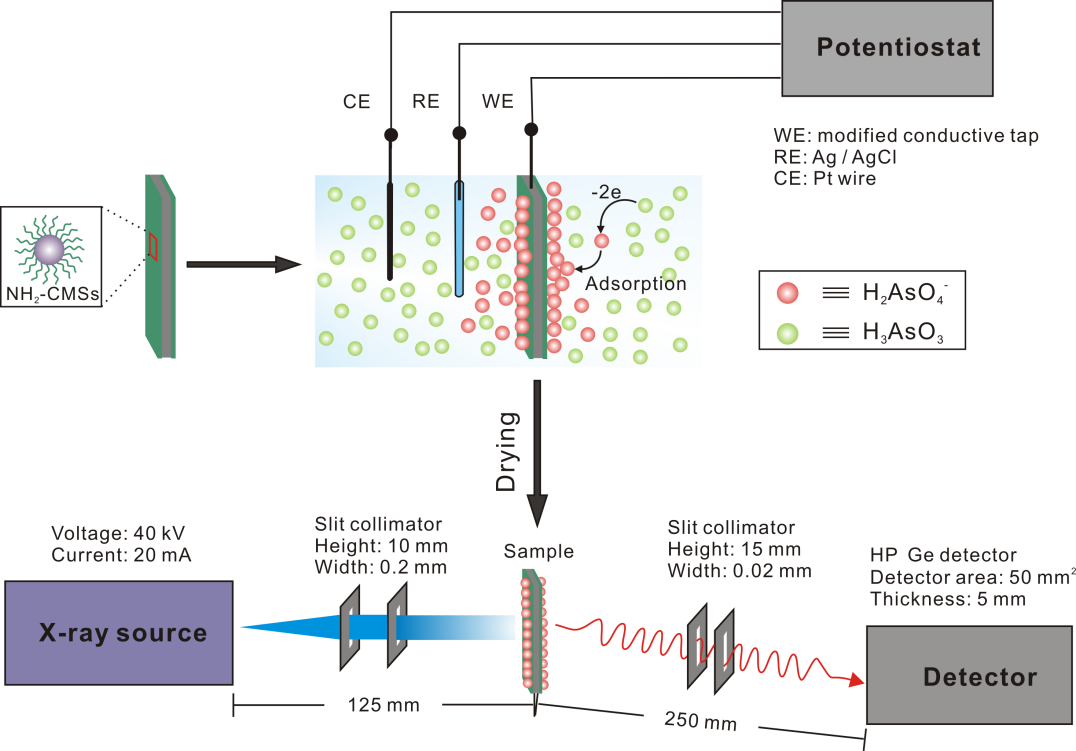The pollution of As(III) in drinking water has currently raised worldwide concerns of public security due to its notorious toxicity. Among the conventional techniques, electrochemical method is available to detect trace As in water generally. However, the method suffers from difficulty in quantification when working in “unknown” natural environmental water in which some other metal cations coexisted. It is very important to find an efficient system to improve the selectivity and the accuracy of the arsenic determination.
Recently, An important progress on determination of trace As(III) using electroadsorption combined X‑ray fluorescence has been made by research group of Prof. Xingjiu Huang and Prof. Jinhuai Liu from IIM. The corresponding results have been accepted by Analytical Chemistry (Anal. Chem. 2015, DOI: 10.1021/acs.analchem.5b01957).
An analytical technique based on electroadsorption and X-ray fluorescence (XRF) for the quantitative and selective determination of As(III) in aqueous solution with ppb-level limits of detection (LOD) is proposed. The approach uses electroadsorption to enhance the sensitivity and selectivity of the arsenic XRF analysis. In electro-adsorption procedure, As(III) could be oxidized to H2AsO4- by a positive electricity field around adsorbents (NH2-CMSs). Meanwhile, the positive charges existed on the NH2-CMSs modified tap surface provided a driving force for the transfer of H2AsO4-, which were electro-attracted from the solution onto adsorbents. Then, H2AsO4- was fixed onto the surface of NH2-CMSs by ionic attraction. Afterwards, the adsorbents with adsorbed H2AsO4- were characterized using XRF analysis after dried in the air. It is worth to mention that the positive electricity field around adsorbents in electro-adsorption experiments can repel the metal cations nearby the adsorbents to solution, so the interference from other metal ions can be ignored in determination of As(III).
This work is supported by the National Basic Research Program of China, the National High Technology Research and Development Program of China (863 Program), and the National Natural Science Foundation of China.

Experimental setup for electro-adsorption assisted direct determination of As(III) using transmission X-ray fluorenscence spectroscopy. Conductive tap modified with NH2-CMSs are used as solid substrate for electro-adsorption of arsenic. Such a substrate concentrated with arsenic is directly for XRF measurement after drying. (Imaged by Tian-Jia JIANG)
For the article click here: http://pubs.acs.org/doi/abs/10.1021/acs.analchem.5b01957
Title: Electroadsorption-Assisted Direct Determination of Trace Arsenic without Interference Using Transmission X‑ray Fluorescence Spectroscopy
Contact:
Prof. Xing-Jiu HUANG, Ph. D
Institute of Intelligent Machines, Chinese Academy of Sciences, Hefei 230031, China
Tel: 86-551-6559-1167
Email: xingjiuhuang@iim.ac.cn (X.J.H)
